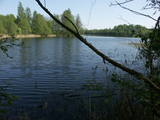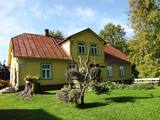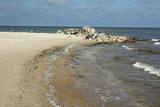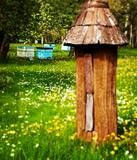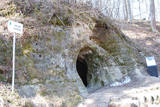| Nr | Name | Beschreibung |
|---|---|---|
|
Igaunijas jūras ūdeņos ir saskaitīta 1521 sala! Salu sarakstā pēc platības (63 ha) ~ 2,5 km garā Mohni sala ieņem 38. vietu. Lai saudzētu salas trauslo veģetāciju (vietām nedaudz atgādina krūmainu tundru), tās vidusdaļā ir izveidotas koka laipas. Salas dienviddaļā atrodas sašaurinājums, kuru tāpat kā blakus esošo jūras krastu klāj viens no savdabīgākajiem Igaunijas akmeņu laukiem. Salas ziemeļos esošās Mohni bākas (Mohni tuletorn) celtniecība pabeigta 1871. g. un tās gaisma ir redzama 10 jūras jūdžu attālumā. Šī ir viena no skaistākajām Ziemeļigaunijas bākām! Līdz Mohni salai var nokļūt ar laivu (iepriekšēja pieteikšanās) no ~ 5 km attālās Vīnistu ostas (Viinistu sadam). Ar jūras laivu vai kajaku piemērotos apstākļos būs ~ 1h ilgs brauciens. Jārēķinās, ka uz salas nav pastāvīgo iedzīvotāju! Vīnistu ciemā apskatāms 2002. g. izveidotais Vīnistu mākslas muzejs (Viinistu kunstimuuseum). Apmeklētājus iespaidos ne tikai tā āriene, bet arī tapšanas vēsture. |
||
|
Wenn Sie einen aktiven Lebensstil genießen, ist diese Tour der perfekte Weg, um das im Gauja-Nationalpark verborgene Erbe aus verschiedenen Perspektiven zu genießen. Das Radfahren beginnt in Strenči und führt an zwei lokalen Brauereien in Brenguļi und Valmiermuiža mit schönen Cafés und gutem Bier vorbei. Sie wandern durch wunderschöne Wälder und entlang der Sandsteinklippe von Sietiņiezis in Richtung Cēsis mit seiner bezaubernden mittelalterlichen Altstadt. Kanufahren findet von Cēsis nach Līgatne statt, einem der schönsten Teile des Flusses Gauja mit seinen Sandsteinbänken, abgelegenen Gehöften und der altmodischen wasserbetriebenen Fähre. Das historische Zentrum von Līgatne ist mit der Entwicklung seiner Papierfabrik verbunden. Hier können Sie auch lokale Wein- und Handwerksproduzenten besuchen, die sich in einer der für die Region typischen künstlichen Höhlen befinden. Spazieren Sie auf den Līgatne-Naturpfaden, um lokale Wildtiere in einer Waldumgebung zu sehen. Am Ende radeln Sie von Līgatne nach Sigulda, einer der beliebtesten Sehenswürdigkeiten in Lettland. Sie sehen die mittelalterlichen Burgen von Turaida und Sigulda, die Gutman-Höhle und andere malerische Aussichten.
|
||
|
Lettlands jüngster Nationalpark (2007) befindet sich im “Land der blauen Seen” - der Region von Latgale. Eins der Ziele der Errichtung eines Nationalparks besteht in der Bewahrung der natürlichen Reichtümer der Region. Der See Rāzna, der zweitgrößte See Lettlands, befindet sich dort und der See Ežezers, der mehr Inseln als irgendein anderer in Lettland aufzuweisen hat. Es gibt auch andere Gewässer und auch typische Hügellandschaften und ein einzigartiges kulturelles Umfeld. Eins der beliebtesten Ziele im Park ist der Mākoņkalns Berg, von dem man einen wunderschönen Blick auf den Rāzna See hat. Die Verwaltung des kürzlich geschaffenen Parks arbeitet an einer touristischen Infrastruktur - Pfade, Routen usw. Vielleicht sollten die Touristen ihren Ausflug in den Rāzna Nationalpark noch etwas verschieben.
|
||
|
Dabas parks, kura lielāko daļu aizņem neprastās formas un līčiem bagātais Cārmaņa (arī Cārmins) ezers. Ezera ūdens ir ļoti tīrs, tādēļ tajā sastopamas Latvijai retas augu sabiedrības. Tā kā parka teritorijā nav tūristiem veidota infrastruktūra, interesenti var baudīt skatus, kas paveras uz ezera un tā apkārtni no Aulejas – Grāveru ceļa.
|
||
|
Das Museum befindet sich in Aknīste, an der Kreuzung der Skolas Straße und Miera Straße. Dieses Museum ist noch ein Ort, der bei der Erkundung der Kultur und der Geschichte der Region Sēlija helfen wird. In dem Museum (eingerichtet im Jahr 1988) kann man eine Sammlung von Altertümern (aus der Steinzeit und Bronzezeit) und Gegenstände besichtigen, die über berühmte Persönlichkeiten aus der Gegend und die Kultur der Selen erzählen. Besonders wertvoll ist die Sammlung des Geschirrs der Selen. |
||
|
Found in the Alsunga Museum, the workshop has been open since 2009, showing people how various ceramics can be made from clay. Visitors can try their hand at the task or just watch as the clay is shaped, spun and, finally, glazed. |
||
|
Eingerichtet im elterlichen Haus „Skudrās” des lettischen Komponisten und Dirigenten Pēteris Barisons (1904 – 1947). Man kann Gegenstände aus dem Besitz des Komponisten, Musikinstrumente, Dokumente u. a. anschauen. Führungen nach vorherigen Anmeldung. |
||
|
Der alte Leuchtturm vom Kap Kolka – am Ende des Kaps kann man das
von Wellen abgespülte Gemäuer des im 16. Jahrhundert gebauten und
mehrmals erneuerten Leuchtturmes sehen. Nach jedem großen Sturm und
kälterem Winter werden diese aber immer kleiner. Früher befanden sich die
Trümmer tiefer im Festland, doch jetzt verschwinden sie langsam unter Wasser.
|
||
|
Das Restaurant befindet sich am Rande der Straße Turaida – Ragana. Die Getreidedarre (2004) wurde entsprechend den alten Traditionen als ein Zeugnis dafür gebaut, dass der Baron Holstein die Getreidedarre des Landgutes von Turaida gebaut hatte. Lettische Küche: Geräucherter Wels, Lammschenkel, Kalb-, Hirsch- oder Schweinebraten, gefüllte Ente oder Gans. |
||
|
In dem reizvoll gelegenen Hof, in dem die Landwirtschaft nach einer umweltfreundlichen Philosophie erfolgt, werden etwa 300 Bienenvölker gehalten. Zur Befriedigung der Bedürfnisse der Besucher gibt es einen Hofladen und einen Verkostungsraum. Auf dem Hof kann man Honig aus verschiedenen Blütentrachten kaufen, Pollen (als gesondertes Erzeugnis oder mit Honig vermischt), Propolis (als gesondertes Erzeugnis oder mit Honig vermischt), Bienenbrot, Wachskerzen und andere Souvenirs. Aug dem Hof werden Verkostungen veranstaltet, die auch Met umfassen, zudem gibt es Führungen. |
||
|
1855, als einen Schiffahrtsweg getieft wurde, wurde im Haff unerwartet eine Bernsteinablagerung gefundet. In der Zeit zwischen 1860 und 1890 wurde dort 2250 Tonen Bernstein gewonnen, einbezogen einzigartige Bernsteingegenstände aus der Jungsteinzeit und der Bronsezeit. |
||
|
Die Ruinen der Ordenburg Helme befinden sich an der Landstrasse Pärnu-Valga auf steilen Hügeln. Die Burg gehörte früher den Deutschen, den Russen, den Litauen und den Schweden, die es 1658 zerstört haben. Unten im Tal gibt es die Artztquelle, deren Wasser 7 Krankheiten heilen soll. Nördlich von der Burg befinden sich die Höhlen Helme, die auch zur Hölle genannt werden. Sehenswert sind zwei Säle. |
||
|
In 1951, when it died, the pine tree had a circumference of 4.63 metres. It was the thickest pine tree in the Baltic States
This is one of the few trees with such a long history for which age has been determined by counting up circles – 370 years. All that’s left is a conserved part of the stump at the side of the road. Cross-sections of the stump are on exhibit at the Latvian Museum of Nature and the Latvian Ethnographic Open-Air Museum.
|
||
|
A very beautiful and expressive tree, it is found on the land of what was once the Vīceži Semi-estate.
|
||
|
Der Bauernhof befasst sich mit der Ziegenzucht und Herstellung verschiedener Ziegenmilchprodukte, aus denen Ziegenkäse und andere Produkte hergestellt werden. Auf dem Feld neben dem Bauernhof werden auch Kartoffeln, saftige Erdbeeren und andere Produkte angebaut. In der Sommerlaube können ca. 15-20 Menschen am Tisch sitzen und gemütlich miteinander reden. Es wird eine leichte Kost angeboten, die zu 100% aus den Produkten des Bauernhofs zubereitet wird. |
||
|
Reškutenu (Reškutėnai) ciema apkārtnē ir atjaunots neliels mitrājs, kura malā uzcelts putnu vērošanas tornis. Ja paveicas, pavasaros te var dzirdēt vai redzēt tādas retas un aizsargājamas putnu sugas kā ķikutu Gallinago media, ormanīti Porzana porzana, melnkakla dūkuri Podiceps nigricollis, griezi Crex crex u.c. Ciema ainava īpaši pievilcīga ir pieneņu un ābeļu ziedēšanas laikā. No putnu vērošanas torņa var redzēt vietas, kur akmens laikmetā dzīvojuši cilvēki. Blakus esošajā purvainajā pļavā bijis ezera līcis, kur tika būvēti ciemati līdzīgi kā Āraišu ezerpils gadījumā. |
||
|
Saimniecībā "Jauncaunes", Ogres novadā, grupām, kā arī individuāliem apmeklētājiem tiek piedāvāta atpūta brīvā dabā, iepazīstot un izmēģinot metamos ieročus, šaušanu ar dažāda veida lokiem, arbaletiem un pneimatiku. |
||
|
Interesantā būve, kurai Baltijas valstīs grūti atrast līdzinieku, ir meklējama 2 km ziemeļaustrumos no Kirblas (Kirbla). 307,8 m garo arkveida tiltu pāri Kazari upei (Kasari jõgi) uzcēla 1904. g. deviņu mēnešu laikā. Tajā brīdī to uzskatīja par Eiropas garāko šāda tipa dzelzsbetona tiltu. Tagad to var šķērsot tikai ar kājām vai ar divriteni. Tumšajā diennakts laikā tilts ir skaisti izgaismots! Tā ievērojamais garums ir skaidrojams ar apstākli, ka pavasara palos Kazari palienes applūst lielās platībā. |
||
|
Ein historischer Weg von Rīga nach Liepāja durch Jelgava, Dobele, Saldus, Skrunda, Durbe un Grobiņa ist schon seit dem 13. Jh. bekannt. Vom Altertum zeugen auch die Reste der skandinavischen Siedlung in der Nähe von Grobiņa. |
||
|
SIA "Limbažu Tīne" ir vilnas pārstrādes uzņēmums ar senām mājas tekstila tradīcijām, kas dibināts jau 1914. gadā. Šobrīd uzņēmumā tiek ražota vilnas dzija, austi augstvērtīgi vilnas un linu audumi, segas, parklāji, pledi, galdauti, dvieļi, lakati un citi tekstilizstrādājumi. Limbažu Tīne ražo etnogrāfiskos audumos pēc autentiskajām Baltijas reģiona kultūrvēsturiskā mantojuma paraugiem. |
||




